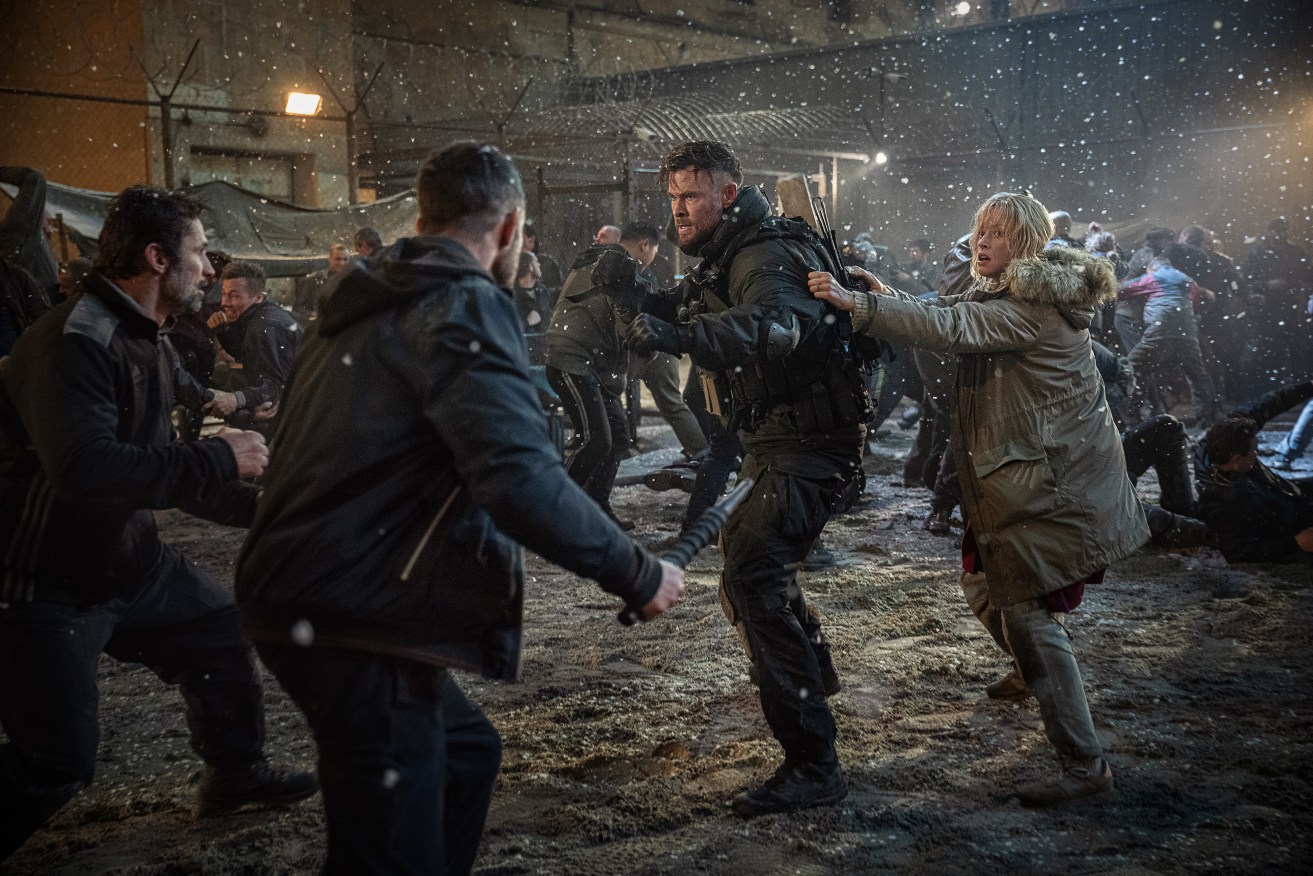‘An existential threat’: Tom Cruise lobbies against AI on behalf of striking actors and stuntmen


Chris Hemsworth keeping it real in Extraction 2. Photo: Netflix
Can you imagine a John Wick fight scene, a Mission: Impossible or Extraction 2 action sequence not employing talented and trained background actors and stuntmen for their big budget blockbusters?
Do the studios opting for green-screen mapping and software to create computer-generated fighters overuse CGI and allow it to dominate their movies?
True action stars, such as Keanu Reeves, Tom Cruise and Chris Hemsworth, know the worth of a real fight.
With about 160,000 actors now on strike across the US joining the 11,500 members of the Writers Guild of America (who walked out on May 2), one of the major stumbling blocks in negotiations with studios has been the use of AI in generating and perpetuating actors’ likenesses.
Struggling US-based Australian actor Luke Cook took to TikTok this week to point out the harsh reality of life as a working actor, and also to highlight the push by studios wanting to use artificial intelligence to replace background performers and extras.
Cook (Chilling Adventures of Sabrina, Modern Family, Guardians of the Galaxy Volume 2) paints a chilling picture.
“Studios are wanting to scan extras for one day of work and then use their likeness in perpetuity … forever … without the consent of the actor in their shows and in their movies.
“If you want to understand where an actor’s head is at, there are actors who will say yes to that … a $200 pay day … just to make rent,” he said in his Tuesday post.
In essence, as Cook explains, an actor’s body and/or face is scanned for a one-off fee, with the image available to be used endless times.
Tweet from @getFANDOM
That’s just one of the main roadblocks in negotiations between actors and writers and the studios.
Another is the stunt men and women and their rights … and who better to be the voice of reason than Mr Stunt Man himself, Mission: Impossible‘s Tom Cruise?
Hot off the extended promotional tour and premiere of Mission: Impossible: Dead Reckoning Part 1, Cruise has spoken at length about his passion for performing his own stunts and authentic movie-making techniques.
This week it was revealed Cruise, 61, joined a SAG-AFTRA (Screen Actor’s Guild and the American Federation of Television and Radio Artists) negotiating session last month to support the union’s proposals on more protections against AI, and also to lobby for better pay and safeguards for stunt workers. Multiple media outlets reported “no other actor of his stature” has come to the table to help resolve this dispute.
Cruise joined the Zoom session to urge the Alliance of Motion Picture and Television Producers (AMPTP) to hear SAG-AFTRA’s concerns about AI and stunt performers.
According to The Hollywood Reporter, the union “had a handful of proposals on the table concerning stunt professionals, including stunt coordinators and stunt performers, which the 160,000-strong union represents” with Cruise wanting “to urge the AMPTP support the guild’s position on stunt performers”.

Ah, gone are the days when real actors were used in big budget movies! Here’s Mel Gibson in Braveheart with hundreds of extras in 1995. Photo: Getty
While Cruise brought enormous gravitas to the table, it was to no avail. Tens of thousands of actors are now in the second week of their strike (which began on July 14), while Writers Guild of America (WGA) members are in the second month of their strike action.
SAG-AFTRA executive director Duncan Crabtree-Ireland, says talks with the AMPTP broke down over three main issues – streaming residuals, the impact of AI technology and union member earnings – making strike action inevitable. He said the current streaming model has “undercut performers’ residual income and high inflation has further reduced our members’ ability to make ends meet”.
The union also focused on “ensuring that performers give consent and are appropriately compensated when their performances are ingested” into AI technology.
“To complicate matters further, actors now face an existential threat to their livelihoods with the rise of generative AI (artificial intelligence) technology,” Crabtree-Ireland said.
“We proposed contract changes that addressed these issues, but the AMPTP has been uninterested in our proposals.”
It’s worth noting the majority of the members in the union work as regular actors, co-stars, guest stars, background actors as well as the 7700 male and female professional stunt workers.
Members of both unions continue to gather on picket lines outside major studios in Los Angeles and New York.
In its response, the AMPTP said it presented a deal that offered “historic pay” and the highest residual increases in 35 years, according to US broadcaster ABC.
It “also offered substantially higher caps on pension and health contributions, audition protections, shortened series option periods, and ‘a groundbreaking AI proposal that protects actors’ digital likenesses for SAG-AFTRA members’.”
“Rather than continuing to negotiate, SAG-AFTRA has put us on a course that will deepen the financial hardship for thousands who depend on the industry for their livelihoods.”
Tweet from @theogweofdelta
AI and has been used for decades and is here to stay. It can be heard in synthesised voices, seen in visual effects (such as deep fakes) and “de-ageing”, as well as in software designed to create massive hordes that would once have required thousands of expensive extras.
In a 2022 piece at computer and gaming website CNET, it was pointed out how software programs were designed specifically for Lord of the Rings “to create computer-generated armies using artificial intelligence to simulate realistic battles” and in Avengers: Endgame.
“[You] can see the impact by simply looking at the films that the software has been used on since Lord of the Rings over the past 20 years,” says Bob Thompson, founding director of the Bleier Center for Television and Popular Culture at Syracuse University.
“It’s a pretty substantial list of films and TV.”
While LotR director Peter Jackson dealt with hundreds of crew, extras and stuntmen, to recreate the enormous battle scenes with tens of thousands of orcs would have been impossible without CGI.
Who needs actors when computers can do it all?
AI took years off Harrison Ford in scenes for Indiana Jones and the Dial of Destiny, his fifth and last outing as the whip-cracking archeologist, and was used to bring back voices and stars of the dead actors in the Star Wars movies.

Doing his own stunts. Actor Keanu Reeves on the set of John Wick 3: Parabellum in 2018. Photo: Getty
Last month, Reeves told Wired magazine of a clause in his contracts that bans studios from digitally editing his performances.
“If you go into deep fake land, it has none of your points of view,” he explained. “That’s scary.”
Like Cruise, he also loves his stunt men, famously rewarding them over the franchise’s journey with personalised $10,000 Rolex watches, and earlier with Harley-Davidson motorcycles for 20 stunt workers on The Matrix.
Queensland-born US-based stuntman Haydn Dalton, who has worked in the movie business for almost 30 years on films including Furiosa, Pirates of the Caribbean, Godzilla and The Hangover, tells The New Daily that viewers will always want to believe a real person is behind a clever action sequence.
Wanted: ‘A sense of reality’
Dalton has been a union member since 2012, and joined colleagues and writers on the picket line in LA on July 18 for better pay and conditions and safeguards.
“Although people want to watch movies and TV shows as a form of escapism, they still want to feel a sense of reality to what they are viewing,” he says.
“They want to believe that a real person, that a real stunt man or stunt woman actually performed the action … that a real person risked being hurt or injured to create the action that they are viewing.
“Through their training, stunt men and women bring true realism and believability to action sequences in movies.
“This can’t be achieved via AI in a true sense.
“Unless a stunt person is actually performing the action it will never truly ‘sell’ as being believable to the viewing audience.
“Let’s be honest, if you knew that everything was fake within a movie – the actors, the stunt people and the action, it doesn’t make the film anywhere near as enjoyable or exciting.
“We, as the viewing audience, want to believe that real people performed as the actors or stunt people – it adds to the escapism that we can somehow be like them,” he says.
This is the first time both unions have been on strike since 1960.








